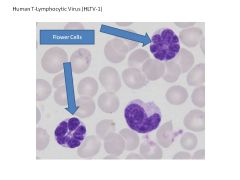![]()
![]()
![]()
Use LEFT and RIGHT arrow keys to navigate between flashcards;
Use UP and DOWN arrow keys to flip the card;
H to show hint;
A reads text to speech;
13 Cards in this Set
- Front
- Back
|
Retrovirus:
Geometry Envelope/Naked Genome Type Genes Carried |
Retroviruses:
Enveloped, icosahedral Capsid contains TWO COPIES of (+) RNA genome (only diploid virus) Genes Contained: gag: group specific antigen; internal proteins (capsid, matrix, nucleic acid-binding prots) pol: reverse transcriptase, integrase, RNase H, Protease env: envelope glycoproteins |
|
|
How are retroviruses different from RNA viruses?
|
Retroviruses contain RNA-dependent DNA polymerase (AKA Reverse Transcriptase)
|
|
|
Why don't RNA viruses directly synthesize proteins after infection?
What is required to synthesize proteins? |
No RNA dependent RNA Polymerase, needs to make negative sense DNA first
Virion requires reverse transcriptase, integrase, and TWO transfer RNAs (tRNA serves as primer!) |
|
|
What is a provirus?
|
DNA intermediate produced via RNA dependent DNA polymerase (REVERSE TRANSCRIPTASE)
Provirus integrates randomly into host chromosome |
|
|
Function of tat, rev, nef, vir genes?
|
Genes coding for virulence-enhancing proteins in more complex retroviruses (HTLV, Lentiviruses, HIV)
|
|
|
What is the function of Long Terminal Repeat sequences in retroviruses?
|
LTR sequences are non-coding regulatory sequences necessary for integration into host chromosome and which also control gene expression
|
|
|
What are the three subfamilies of retroviruses? Provide examples of each.
|
1) Oncovirinae (Human T-lymphotropic virus-1, 2, -5)
2) Lentivirinae (HIV-1, -2) 3) Spumavirinae (Human foamy virus) |
|
|
Briefly describe each stage of retroviral infection.
|
1) Bind specific cell receptor, mediated by glycoprots
2) Entry by DIRECT FUSION 3) Reverse transcription of RNA to dsDNA via reverse transcriptase; requires tRNA incorporated into virus from previous host cell 4) RNA displaced and degraded by RNase H; reverse transcriptase now acts as DNA-dep DNA polymerase II and copies new DNA into dsDNA to form PROVIRUS 5) dsDNA circularized and integrated into host cell via INTEGRASE 6) (+)RNA copied from integrated DNA by host RNA polymerase; splice viral mRNA, export from nucleus, and TRANSLATE. This mRNA also codes for gag, pol. 7) Assembly of virion and packaging followed by budding and release of new virions |
|
|
What cell receptors are required for direct fusion of HIV?
|
For HIV: chemokine receptor--CCR5 on macs and CXCR4 on act'd CD4's
|
|
|
Direct vs Indirect Transforming Retroviruses
What class of retrovirus do these belong? |
Belong to onvovirinae (immortalize or transform target cells; they're NOT cytolytic)
1) Direct (acute) transforming retroviruses: oncogene involved; fast disease Gain new genetic info in form of oncogene. Gene originates from cell captured by virus via transduction. Expression may alter phenotype of infected cell. If virus gains gene whose product simulates cell growth, acquisition may enable virus to spread by stimulating growth of cell it infects. NO HUMAN VIRUSES OF THIS TYPE HAVE BEEN ID'D. 2) Indirect or LEUKEMIA retroviruses: transactivation involved; slow disease Cannot transform cells in vitro, but can cause human ca after long latency period >30 years; they're replication competent Cell growth requires trasncriptional regulated called tax. Required for viral replication but can activate cellular genes (IL-2) to promote growth, may contribute to neoplasia |
|
|
HTLV-1:
Disease associations Transmission Mechanism of Infection |
Human T-lymphotropic virus-1:
assoc'd with specific lymphoid malignancies and is endemic in Japan, Caribbean, and AFrica Present in almost ALL cases of adult T Cell Leukemia (ATLL) Can also be assocd with less common neurologic condition called HTLV assoc'd myelopathy/tropical spastic paraparesis (HAM/TSP), presents with dev't progressgive weakness of legs/lower body (~MS) Transmission by cell-cell contact during intimate exchange of body fluids (milk, semen, blood, needles) Infects CD4 cells; characterized by malignant clone of morphologically altered T cells (FLOWER CELLS) Syx: LAD, hepatosplenomegaly, hypercalcemia |
|
|
Lentivirus:
Disease associations Mechanism of Infection |
Slow viruses with neuro/immunosuppressive dz (HIV)
Viruses are cytolytic and NONtransforming HIV infects CD4T cells and mac lineage (monocytes, macs, DC's, mglials)--alters their fn |
|

|

|

